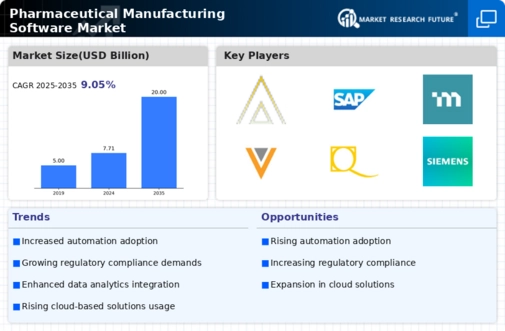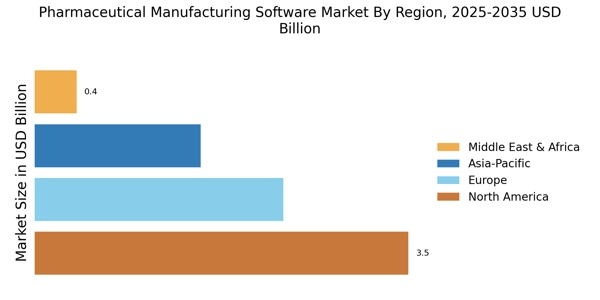Growing Regulatory Pressures
Regulatory pressures are intensifying within the Pharmaceutical Manufacturing Software Market, compelling companies to adopt more robust software solutions. Regulatory bodies are increasingly scrutinizing manufacturing processes to ensure compliance with safety and quality standards. This has led to a surge in demand for software that can facilitate compliance management, documentation, and reporting. The market for compliance-focused software is projected to grow by approximately 15% annually as manufacturers seek to avoid costly penalties and maintain their market position. Thus, the growing regulatory pressures are likely to serve as a significant driver for the Pharmaceutical Manufacturing Software Market.
Rising Demand for Automation
The Pharmaceutical Manufacturing Software Market is experiencing a notable increase in demand for automation solutions. Automation enhances efficiency, reduces human error, and streamlines production processes. As pharmaceutical companies strive to meet stringent regulatory requirements and improve operational efficiency, the adoption of automated systems becomes imperative. According to recent data, the market for automation in pharmaceutical manufacturing is projected to grow at a compound annual growth rate of approximately 10% over the next five years. This trend indicates a shift towards more sophisticated software solutions that can integrate seamlessly with existing manufacturing processes, thereby driving the growth of the Pharmaceutical Manufacturing Software Market.
Increasing Focus on Data Analytics
Data analytics is becoming a cornerstone of the Pharmaceutical Manufacturing Software Market. The ability to analyze vast amounts of data allows manufacturers to optimize production processes, enhance product quality, and ensure compliance with regulatory standards. With the rise of big data, pharmaceutical companies are increasingly investing in software that can provide real-time insights into manufacturing operations. This trend is supported by the fact that companies utilizing advanced analytics report a 20% improvement in operational efficiency. As the industry continues to evolve, the demand for data-driven decision-making tools within the Pharmaceutical Manufacturing Software Market is likely to expand significantly.
Emphasis on Supply Chain Transparency
Supply chain transparency is gaining traction within the Pharmaceutical Manufacturing Software Market. Stakeholders are increasingly demanding visibility into the entire supply chain to ensure product integrity and compliance with regulations. This demand is driven by the need to mitigate risks associated with counterfeit drugs and ensure the safety of pharmaceutical products. Software solutions that provide end-to-end visibility are becoming essential for manufacturers. Recent studies indicate that companies with transparent supply chains can reduce operational costs by up to 15%. Consequently, the emphasis on supply chain transparency is likely to propel the growth of the Pharmaceutical Manufacturing Software Market.
Adoption of Modular Software Solutions
The trend towards modular software solutions is reshaping the Pharmaceutical Manufacturing Software Market. Modular systems allow manufacturers to customize their software according to specific needs, facilitating easier upgrades and integration with existing systems. This flexibility is particularly appealing to companies looking to adapt to rapidly changing market conditions and regulatory requirements. As a result, the modular software segment is expected to witness a growth rate of around 12% in the coming years. This shift towards modularity not only enhances operational efficiency but also supports the overall growth trajectory of the Pharmaceutical Manufacturing Software Market.


















Leave a Comment